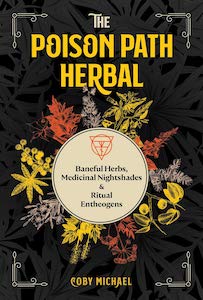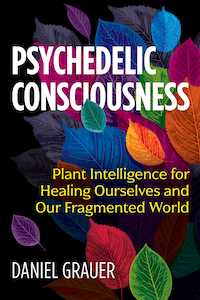
The Poison Path Herbal: Baneful Herbs, Medicinal Nightshades, & Ritual Enthogens, by Coby Michael
Park Street Press, 978-1644113349, 256 pages, 2021
Any book that has a large warning at the start of it gets my attention. The Poison Path Herbal: Baneful Herbs, Medicinal Nightshades, & Ritual Enthogens by Coby Michael is not here to play. It’s here to teach you reverence and respect for this particular path, and above all, it’s here to transmute your life.
A practitioner of the Poison Path of occult herbalism and cultivator of entheogenic herbs, Michael is perfectly positioned to take the reader on this journey through the misunderstood baneful herbs. As well as practicing, he also contributes to the Pagan Archives at Valdost University, writes regularly for The House of Twigs, and maintains his own blog on Patheos Pagan called Poisoner’s Apothecary. Somehow in the midst of all that, he teaches classes and online workshops on plant magic, baneful herbs, and traditional witchcraft.
Michael dives right into the subject, explaining that this book is “focused on the magical and spiritual uses of baneful herbs, entheogens, and plant spirit allies as well as their history and mythology.”1 He goes on to explain a few terms that are used generously throughout the book such as baneful which “refers to the ability of a thing to cause harm, and because of this threat, the baneful thing becomes taboo and gains a sinister reputation.”2
Baneful things, especial when talking about plants, can cause bodily harm and in some cases death if the practitioner isn’t clear on what they are doing. The book is separated into three parts, with part 1 covering off the basics of the poison path, Part 2 discussing the three ways of the poison path, and the last section which deals with bringing that knowledge together in practice. It’s very well laid out and a thoughtful path to follow if you are just starting your journey on this particular path.
Be warned though: this isn’t a gardening book, nor is it a how-to for using plants to hex your ex or find a job. Some of the information presented might be bit overwhelming if you don’t have a regular spiritual practice; as with any undertaking similar to this, you can expect to be changed by the process. Michael cautions against simply jumping in and instead recommends learning about the herbs’ chemistry and how the various plants affect human physiology.
I had the notion of reading this book and then being able to find alternative solutions for my anxiety. Anxiety is not fun and presents different symptoms in many forms in those who experience it, and for me personally, it can be debilitating at times. I don’t like taking prescription medication because it makes me feel dull, so looking for another way to help myself is what prompted me to read this book. After going through it however, I realize that there’s much more to this than simply making a cup of herbal tea and wrapping myself up in a cozy blanket while I wait for the mind-goblins to quieten down. This is an actual path to follow and it is directly linked with Shadow Work. There is no spiritual bypassing here.
Fortunately, Michael seems to have understood this, as he writes clearly about the various families of plants and lists what they are used for. He also addresses the notion of using poisonous plants as spirit allies in magical practice despite the danger they present. He stresses the importance of personal exploration, as there is no substitute for your own counsel in such personal things. Such learnings do have a price though, as Michael clarifies, “…we learn to work with our own shadow as well as the darker forces of the natural world.”3
Having laid out the various plant families and their uses, Michael moves on to discuss the crossroads on the path of poison. This is where it gets a bit advanced; if you aren’t familiar with planetary influences you might find yourself scratching your head and wondering what the hell you’re reading. On the assumption that the reader has a working knowledge of planets and their influences, Michael writes brilliantly about Mercury, Venus and Saturn: the three paths of poison. He arranges them visually in a triangle, a shape that represents the traditional threefold worldview that many pagan cultures subscribe to.
This collection of planetary influences is the basis for the Poison Path, and a profound one. Michael says, “The archetypal forces of Saturn, Venus, and Mercury are aligned with the currents of magic, witchcraft, and plant lore, providing powerful allies to one’s craft… their association with boundaries and liminal spaces in addition to their correlation with the other world and witchcraft mythos are the powerful themes expressed in this book.”4
Those themes run through the book, making the reader either cringe at the thought of having to learn more information on planets and such, or is an absolute delight to those who have working knowledge and wish to add to it. Planetary magic is not easy, and when baneful herbs are included as an accompaniment it becomes challenging for those not accustomed to specific terms and phrases.
There is a lot of information in The Poison Path Herbal that might not be appropriate for those who live in the ‘good vibes only’ section of the chorus, as much of this book is dedicated to personal gnosis and the responsibility inherent in achieving that gnosis. I will be adding this book to my collection simply because it doesn’t coddle or coerce: this book demands your undivided attention and promises great rewards for doing so. Alternatively, if you aren’t prepared to go all in, you might want to pick up a different book. Out of respect for the writer, if you aren’t prepared to shovel your personal shit, don’t try to use this book as a way to cover it up.

Sarrah October Young is a writer and practising witch who wished she could do stand-up comedy. When she isn’t writing or witching, she can be found posting about her cats on IG @therealoctober.



